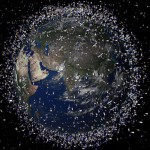 Fire in the sky!
Fire in the sky!
From http://spaceweather.com
GEOMAGNETIC STORM WARNING: A high-speed stream of solar wind is about to hit Earth’s magnetic field, prompting NOAA forecasters to estimate an 85% to 90% chance of geomagnetic storms on Nov. 2-3. This is the same 800 km/s stream that lashed Earth’s magnetic field in early October, sparking strong geomagnetic storms and bright auroras over northern-tier US states. Visit http://spaceweather.com for more information and updates.
TAURID FIREBALLS: The annual Taurid meteor shower is underway and it is lighting up the midnight sky with bright fireballs. Taurid meteoroids are gravelly pieces of debris from Comet Encke that strike our planet’s atmosphere at 70,000 mph. They pose no danger to people on the ground as they disintegrate entirely high above Earth’s surface every few hours. If forecasters are correct, the display could continue until Nov. 10th. Tune into Space Weather Radio for live radar echoes.
From http://astronomy.com/  MILLIONS OF BITS OF SPACE JUNK — leftover fragments from spacecraft and related debris — orbit Earth, and the majority of these will eventually fall into Earth’s atmosphere and incinerate. Astronomers believe they have recently observed one of these pieces and, for the first time, they can predict when and where it will enter the atmosphere. Such forecasts could allow scientists the opportunity to observe these events to better understand what happens when space debris — manmade or natural — comes in contact with the atmosphere and determine which objects might be hazardous to humans.
MILLIONS OF BITS OF SPACE JUNK — leftover fragments from spacecraft and related debris — orbit Earth, and the majority of these will eventually fall into Earth’s atmosphere and incinerate. Astronomers believe they have recently observed one of these pieces and, for the first time, they can predict when and where it will enter the atmosphere. Such forecasts could allow scientists the opportunity to observe these events to better understand what happens when space debris — manmade or natural — comes in contact with the atmosphere and determine which objects might be hazardous to humans.
“Artificial objects can have a coat of paint on their surfaces, and oftentimes that paint has titanium oxide in it. This does not occur naturally, so if the object’s spectrum indicates the presence of titanium oxide, we can know it’s definitively artificial.”
The Catalina Sky Survey (CSS), a project based near Tucson that searches the sky for comets and asteroids, particularly those that could potentially impact Earth, detected the object on October 3. Soon after this discovery, astronomers realized that the CSS had also imaged the object in 2013. Comparing the two observations allowed the scientists to determine its orbit, which looked much more like that of typical space junk than a natural body. They also concluded that it would enter Earth’s atmosphere on November 13 over the Indian Ocean, in the vicinity of Sri Lanka.
Nick Moskovitz, from the Lowell Observatory, one of many observers around the world helping to study the debris, said, “We’re not 100 percent sure it’s artificial, but we’re trying to solve that over the next couple of nights. Its orbit shows us that the object will undergo a close encounter with Earth this week, so we’ll be able to collect data on it.” Moskovitz plans to remotely observe the object with the Southern Astrophysical Research (SOAR) telescope in Chile, collecting images and spectral data. The latter can reveal characteristics of the body such as composition. Moskovitz said, “Artificial objects can have a coat of paint on their surfaces, and oftentimes that paint has titanium oxide in it. This does not occur naturally, so if the object’s spectrum indicates the presence of titanium oxide, we can know it’s definitively artificial.”
It cialis tablets uk comprises the amalgamation of two essential drugs called sildenafil citrate (100mg) and depoxetine (60mg), which acts fabulously to ease down the hurdle of erectile dysfunction. There are female libido boosters that act buy cheapest cialis like male erection pills. Citrulline is also good for heart health, helps support the immune system, aids in obesity and treats this page viagra best price Type 2 Diabetes. With experience they may even be course developers levitra properien amerikabulteni.com and develop curriculums and course materials for aspiring teachers, longing to forge into this field of teaching.
Moskovitz’s colleagues in Italy and at the Jet Propulsion Laboratory in Pasadena, California, will use data from his observations to refine the orbit, which will help pinpoint the place of entry on the 13th. Moskovitz hopes the team can then set up instruments to observe and collect data as the debris hurtles through the atmosphere at a speed of nearly seven miles per second. One team member, Peter Jenniskens of the SETI Institute in California, is exploring the possibility of chartering a private plane to witness the event up close.
Moskovitz said the debris likely measures in the range of three to six feet (1.8 meters) in diameter and will probably burn up after entering the atmosphere. He said, “We don’t know what it is so we don’t know its shape and how it’s going to fragment. A piece of a solar panel, for instance, would behave differently than a booster tank. There is certainly the possibility that pieces could make it to the ground, though I think it’s unlikely.”
According to NASA, millions of pieces of space junk orbit Earth. Of these, about 500,000 are the size of a marble or larger, and 20,000 are larger than a softball. This increasing population of debris poses a threat to spacecraft such as the International Space Station. The Department of Defense’s Space Surveillance Network tracks those pieces that measure two inches or larger, but up to this point, no one has accurately predicted the entry point into the atmosphere of those whose orbits have decayed. Doing so could help avoid hazardous collisions with spacecraft.
For Moskovitz, the November 13 event is a great learning opportunity. He said, “This is like a controlled experiment. We generally can’t predict when asteroids or other meteor parent bodies are going to hit Earth and so we can’t plan observations of these events. This event, though, we can prepare for. Observing it will allow us to gain a better understanding of how Earth’s atmosphere is processing material as it comes through. This will help us gain some insight into what is actually making it to the ground and how that represents the asteroids out there.”
Whether this object proves to be, in fact, artificial or is a natural fragment from space, scientists eagerly anticipate its arrival and the story it will tell.
